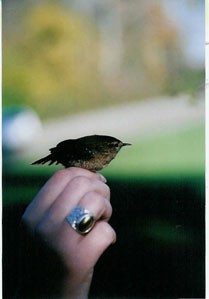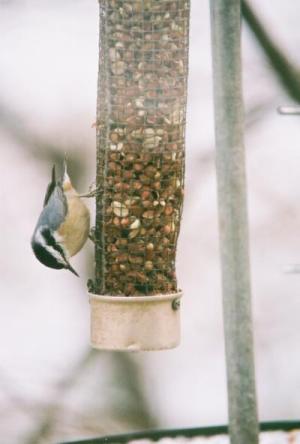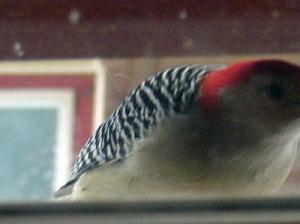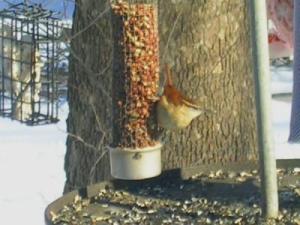I would like to hear what people in other parts of the country are seeing at their bird feeders. Since the winter finches are making a southerly push this fall, there may be some interesting birds showing up at your feeders. Some of the birds to look out for will be pine siskins, red and white-winged crossbills, Bohemian waxwings, common and hoary redpolls, red-breasted nuthatches, maybe some others.

Add your voice! Click below to answer. ThriftyFun is powered by your wisdom!
The photo I posted above is a Winter Wren. This is a regular visitor to Missouri during the colder months of the year. This was one which we banded at Missouri Western State University Campus, Saint Joseph, Missouri.
Here's what we get in the southeastern corner of Virginia: cardinals, titmice,nuthatches, siskins, black-capped and Carolina chickadees, Virginia creepers, house and Carolina wrens, purple and house finches, painted buntings, redwings,juncos, peewees, viereos, towhees, cowbirds, red-breasted grosbeaks, bluejays, almost every kind of sparrow.
I live in cold Nova Scotia Canada. We get blue jays lookin for peanuts in a shell. They take all they can get and hide them and come back later and seem to know exactly where they are hidden. Sometimes the crows find them first! I wish we had the variety that you have in a warm climate. Happy bird watching from Canada
This afternoon we had a little Red-breasted Nuthatch show up at our backyard feeders.
It is a little unusual for us to get these. Our regular visitors unclude, Downy, Hairy and Red-headed Woodpeckers, Northern Flickers, Black-capped Chickcadees, White-breasted Nuthatches, American Goldfinch, Blue Jays, Northern Cardinals, Dark-eyed Juncos, Common Grackles, House Sparrows and European Starlings.
Maybe this winter we will get an Evening Grosbeak. I have not ever seen one of these in Missouri!
In southern Australia we are in spring. The birds that are visiting our feeder are Sulphur Crested Cockatoos, sparrows, pink galahs, wattle birds, scarlet brow finches, crimson rosellas, native thrush, blue fairy wrens and bush wrens. We feed out a wild parrot bird mix and there seems to be something for all of them. We spent many happy hours watching their antics.
We had a bear bend our bird feeder in half last week to get to the feed. We live in Central Pennsylvania. I think that is the biggest "bird" we have ever attracted...
TDunleavy, a Black Bear would be awesome!
But I think I would rather get an Evening Grosbeak or Bohemian Waxwing. Are you getting either one of these at your feeders?
I love the birds that turn up at my feeder everyday. They are red birds, blue jays, mourning doves, cow birds, wood peckers titmice and nuthatches and some that I really don't know what they are, I just know that I love watching them.
I live in Va.Down the road a little ways from Roanoke Va.
Thanks for asking this question, as it was interesting to see what all types of birds everyone else has as well.
Teresa from Va.
Housefinches, goldfinches american, lesser goldfinch, black-capped chickees, bushtits, scrub jay, house sparrows, oregon junco, from Springfield, Or
Here is one of the photos I took of the little Red-breasted Nuthatch on the peanut feeder in our backyard. This was November 22 (Thanksgiving Day).

We are averaging 10 - 12 species of birds daily coming to our feeders. A couple of our favorites are the Red-breasted Nuthatch and the Carolina Wren. Others coming are Downy and Red-bellied Woodpeckers, American Goldfinches, House Sparrows, Dark-eyed Juncos (some people call these, "Snow Birds"), Blue Jays, Northern Cardinals, White-breasted Nuthatches, etc.
For some reason we are not getting the Black-capped Chickadees. This species is usually one of the most commonly found bird coming to feeders. I am not sure why we are not getting them in our yard. Is anyone else noticing the absence of these birds at their feeders?
I haven't seen any black capped chickadees either or much of anything else this year. I think it's all the stray cats roaming around the neighborhood, they eat the bird seed and, I fear, they're eating the birds, too. Well, I guess the poor cats are just trying to survive. Now that the leaves have fallen off the trees I found something surprizing and amusing: a bird nest with a big ziplock plastic bag woven into it!
Today at our feeder we had:
Red-bellied Woodpecker
Downy Woodpecker
Blue Jay
Black-capped Chickadee
Red-breasted Nuthatch
White-breasted Nuthatch
Carolina Wren
Dark-eyed Junco
Northern Cardinal
Common Grackle
House Finch
American Goldfinch
House Sparrow
Still no Pine Siskins, Purple Finch or any of the other "hope for" birds.
I live in Massachusetts just noth west of Worcester. I beleive I saw a red bellied woodpecker at my feeder this morning. Just wondering if this is unusual for this bird to be this far north?

Red-belllied Woodpeckers are routinely found in the eastern half of the US. Only in the extreme northern parts of the northern tier of states would they be found only occasionally. I would say that they would be found in your area pretty regularly. Once it has found your feeder I would also suspect that it will be returning as long as you have seed/peanuts in your feeders.
** Your photo is of a Red-bellied Woodpecker.
We are experiencing a winter blizzard here in Saint Joseph, Missouri. The weather man gave a forecast of 1 to 3 inches of snow, wind at up to 35 miles per hour and low temperatures to 20 degrees F.
Presently there is about 10 inches of snow on the ground (and it is still snowing), the wind is blowing quite heavily and it is 23 degrees F.
The birds are "attacking the feeders". They almost seem to be in a "feeding frenzy". We are getting House Sparrows, House Finches, Downy Woodpeckers, Red-belllied Woodpeckers, Dark-eyed Juncos (affectionately, called "Snow Birds"), White-breasted Nuthatches, Red-breasted Nuthatches, Carolina Wrens, Northern Cardinals and American Goldfinches. There has been a constant mix of these birds (about 50), all trying to fill their gizzards before nightfall.
I wonder what outside will look like in the morning!
Well, it is a sunny morning here in Saint Joseph, Missouri, and it seems all the regulars are back at our feeders. It is only 18 degrees F. but the birds are feeding in a much more leisurely manner this morning. In addition to the birds showing up yesterday, we have added a couple of Black-capped Chickadees this morning.
Here is a Blue Jay getting a little bit of breakfast from the peanut feeder.
So far this morning we have had fourteen (14) species visit.

This Christmas morning there was a pretty good showing of various birds at our backyard bird feeders.
American Goldfinches
Dark-eyed Juncos
Red-bellied Woodpecker
Brown Creeper (in trees near the feeders)
Downy Woodpeckers
Carolina Wren
House Finches
European Starlings (in trees near the feeders)
Pine Siskin (1) on niger seed sock with the goldfinches
Black-capped Chickadees
Red-breasted Nuthatches (2)
House Sparrows
Northern Flicker
Northern Cardinals
Blue Jay
White-breasted Nuthatch
and
a fly over Red-tailed Hawk
Today, the day after Christmas, we had seven PINE SISKINS show up at our backyard feeding station. They were congregating with the American Goldfinches on the niger seed, sock feeder.
Two RED-BREASTED NUTHATCHES continue to be daily visitors to our peanut feeder.
Here is a photo of one of the two Carolina Wrens we have coming to the peanut feeder we have on our feeding station.

The starlings and Common Grackles have been coming to our backyard feeders lately. They tend to be aggressive and cause the smaller birds to take flight. When these bigger birds do leave the feeder area the nuthatches, siskins, goldfinches, Carolina Wrens and other regulars return. * The male American Goldfinches are beginning to molt into their brilliant, golden yellow plumage now!
Come on Spring!
Add your voice! Click below to answer. ThriftyFun is powered by your wisdom!